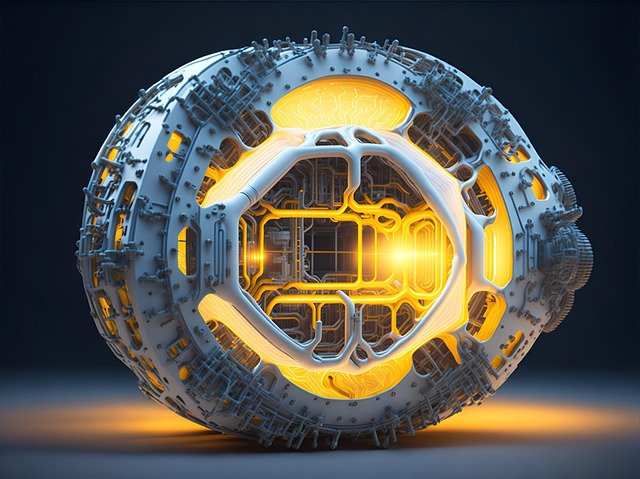Nuclear medicine contrast agents, particularly those used in Myocardial Perfusion Scans (MPS), are powerful tools for cardiac imaging. These agents emit radiation detected by specialized cameras to visualize blood flow and heart muscle function, aiding in the early detection of blocked arteries and impaired heart function, such as ischemia and coronary artery disease. While safe when administered correctly, there are risks like allergic reactions and radiation exposure, requiring careful consideration by healthcare providers. Future advancements aim to enhance patient safety, reduce side effects, and improve image quality through more targeted agents and hybrid imaging systems combining nuclear imaging with MRI or CT.
Discover the transformative role of nuclear imaging contrast agents, particularly in cardiac imaging techniques like Myocardial Perfusion Scans (MPS). This article delves into the science behind these specialized agents, elucidating how they enhance visualization of heart muscle blood flow. We explore the benefits and risks associated with their use, offering insights for informed decision-making. Additionally, we peek into future advancements in nuclear imaging contrast technology, promising more accurate diagnosis and improved patient care.
Understanding Nuclear Medicine Contrast Agents for Cardiac Imaging
Nuclear medicine contrast agents play a pivotal role in cardiac imaging, particularly in procedures like Myocardial Perfusion Scans (MPS). These specialized substances are designed to enhance the visibility of specific tissues or organs within the body, allowing for more accurate diagnosis and assessment. Unlike traditional X-ray contrast agents, nuclear imaging contrast agents emit radiation that can be detected by specialized cameras, providing detailed images of blood flow and tissue function.
The key advantage lies in their ability to pinpoint areas of the heart with reduced blood flow or impaired function. These agents are typically radioactive isotopes that are safely injected into a patient’s bloodstream, where they accumulate in different parts of the heart based on local metabolic activity. By tracking these agents’ movement, healthcare professionals can identify blocked arteries or areas of the myocardium that require more oxygen, enabling early detection and effective treatment planning for cardiac conditions.
How Myocardial Perfusion Scans Work with Contrast
Myocardial Perfusion Scans are a powerful tool in cardiac imaging, utilizing specialized nuclear imaging contrast agents to visualize blood flow within the heart muscle. These scans work by administering a small amount of radioactive tracer, typically a gamma emitter, which is then detected by specialized cameras as it circulates through the cardiovascular system. The contrast agent is designed to accumulate in areas of the heart with optimal blood supply, allowing radiologists to identify regions of the myocardium that may be experiencing reduced blood flow or ischemia.
The effectiveness of Myocardial Perfusion Scans lies in their ability to highlight differences in perfusion, providing valuable insights into the health of the heart’s muscular layers. Contrast agents play a crucial role by enhancing the visibility of these subtle variations, enabling accurate diagnosis and assessment of cardiac conditions such as coronary artery disease or myocardial infarction. This non-invasive technique offers a comprehensive view of the heart’s function, making it an essential tool in cardiovascular diagnostics.
Benefits and Risks of Using Contrast in Cardiac Imaging
Using nuclear imaging contrast agents in cardiac imaging, such as Myocardial Perfusion Scans, offers several significant advantages. These agents enhance the visibility of blood flow and heart muscle function, allowing for more accurate diagnosis of coronary artery disease. By providing detailed images that highlight areas of reduced blood flow or damaged tissue, healthcare professionals can make informed decisions about treatment plans, potentially improving patient outcomes.
However, like any medical procedure, there are risks associated with the use of nuclear imaging contrast agents. These risks include potential allergic reactions and exposure to radiation. While modern protocols aim to minimize radiation doses, repeated exposure over time may still pose a risk. Additionally, some patients may experience mild side effects such as nausea or pain at the injection site. It’s crucial for healthcare providers to weigh these benefits against the risks before administering contrast agents to ensure patient safety and effectiveness in cardiac imaging.
Future Perspectives on Nuclear Imaging Contrast Agents
The future of nuclear imaging looks promising, and advancements in contrast agent technology play a pivotal role in this evolution. Researchers are continually exploring novel compounds that can enhance image quality, reduce side effects, and improve patient safety. One area of focus is developing more targeted and specific agents, allowing for better visualization of specific tissues or pathologies within the heart. These advanced contrast agents could enable early detection and precise characterization of cardiac disorders.
Additionally, there is a growing interest in combining nuclear imaging with other modalities like magnetic resonance imaging (MRI) or computed tomography (CT) to create hybrid imaging systems. Such integration has the potential to provide comprehensive cardiac assessments, offering detailed anatomical information alongside functional insights gained from nuclear imaging contrast agents. This multi-modality approach may lead to improved diagnostic accuracy and treatment planning in cardiology.
Nuclear imaging contrast agents, particularly for myocardial perfusion scans, offer valuable insights into cardiac function and blood flow. By enhancing visualization of the heart muscle, these agents enable accurate diagnosis and management of cardiovascular conditions. While benefits include improved diagnostic accuracy and non-invasive nature, understanding associated risks is crucial for informed decision-making. Future research in nuclear imaging contrast agents focuses on enhancing safety, improving resolution, and exploring innovative delivery methods, promising advancements in cardiac imaging technology.
